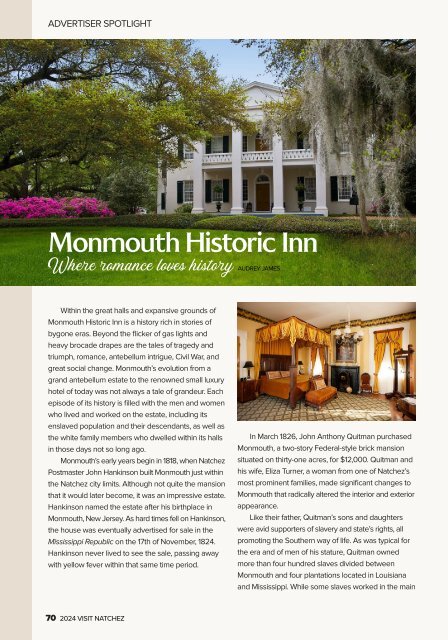You also want an ePaper? Increase the reach of your titles
YUMPU automatically turns print PDFs into web optimized ePapers that Google loves.
ADVERTISER SPOTLIGHT<br />
Monmouth Historic Inn<br />
Where romance loves history AUDREY JAMES<br />
Within the great halls and expansive grounds of<br />
Monmouth Historic Inn is a history rich in stories of<br />
bygone eras. Beyond the flicker of gas lights and<br />
heavy brocade drapes are the tales of tragedy and<br />
triumph, romance, antebellum intrigue, Civil War, and<br />
great social change. Monmouth’s evolution from a<br />
grand antebellum estate to the renowned small luxury<br />
hotel of today was not always a tale of grandeur. Each<br />
episode of its history is filled with the men and women<br />
who lived and worked on the estate, including its<br />
enslaved population and their descendants, as well as<br />
the white family members who dwelled within its halls<br />
in those days not so long ago.<br />
Monmouth’s early years begin in 1818, when Natchez<br />
Postmaster John Hankinson built Monmouth just within<br />
the Natchez city limits. Although not quite the mansion<br />
that it would later become, it was an impressive estate.<br />
Hankinson named the estate after his birthplace in<br />
Monmouth, New Jersey. As hard times fell on Hankinson,<br />
the house was eventually advertised for sale in the<br />
Mississippi Republic on the 17th of November, 1824.<br />
Hankinson never lived to see the sale, passing away<br />
with yellow fever within that same time period.<br />
In March 1826, John Anthony Quitman purchased<br />
Monmouth, a two-story Federal-style brick mansion<br />
situated on thirty-one acres, for $12,000. Quitman and<br />
his wife, Eliza Turner, a woman from one of Natchez’s<br />
most prominent families, made significant changes to<br />
Monmouth that radically altered the interior and exterior<br />
appearance.<br />
Like their father, Quitman’s sons and daughters<br />
were avid supporters of slavery and state’s rights, all<br />
promoting the Southern way of life. As was typical for<br />
the era and of men of his stature, Quitman owned<br />
more than four hundred slaves divided between<br />
Monmouth and four plantations located in Louisiana<br />
and Mississippi. While some slaves worked in the main<br />
70 2024 VISIT NATCHEZ
















